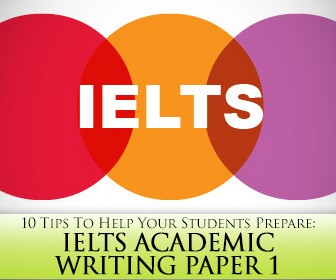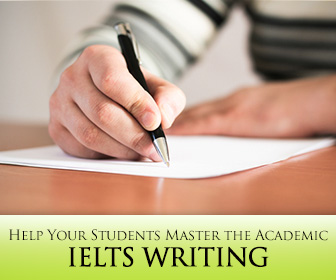IELTS Academic Writing Paper 1: 10 Tips To Help Your Students Prepare


The most common method of proving your level of English outside of the US is through the IELTS exam which is measured by a bands system. It depends on the proposed course of study as to what band the student is required to achieve. Many inexperienced ESL teachers who take up teaching IELTS for the first time do not realize the fact that there are indeed two different examinations that can be taken. There is the General IELTS examination which is required for basic entry level jobs or for immigration purposes and then there is the Academic IELTS examination that has been especially tailored for those learners wishing to gain entry into higher level degrees in foreign educational institutions. The main difference between the Academic and the General IELTS exam lies in the first part of the writing section.
At a first glance the IELTS writing section of the exam can seem rather daunting to both the student and the new teacher. The biggest mistake that is made in the writing section of the IELTS exam is that students do not follow the rubric properly because they are not familiar with the different kinds of texts they are required to produce and therefore they are penalized for not producing what has been asked for – which in turn could cost them their entry into their chosen course and university. What we need to remember as IELTS tutors is the difference approaches when it comes to teaching writing genres with the IELTS academic exam. If you have only being teaching general English you will know that your learners have to know how to write a great number of different pieces including: a thank you letter, letter of complaint, description, narrative, short message, email to a friend, letter of application, report, instructions, summary, newsletter, magazine article or an essay. However, in the IELTS writing exam less is needed, yet teachers still focus on all the different kinds of writings just in case they appear. In fact there’s no “just in case” when it comes to the Academic IELTS exam, if it is not listed on the official IELTS website then it will never “just” appear. In all actuality the IELTS teacher needs to focus more on how to describe data, graphs and charts, processes and maps for part 1 and writing an argumentative, opinion or problem-solution essay for part 2. Teaching IELTS writing is relatively easy compared to other exams, the main thing is that the teacher must not lose focus and teach irrelevant writing styles just because you think it will be beneficial to them in the future, yes, maybe they will help in the future, but your goal is to get them to pass the exam with the band score they need. Here are some useful tips for IELTS teachers when it comes to academic writing.

This, you would think would be a given, however, as mentioned previously many less experienced teachers assume that there is only one IELTS exam. For part 1 of the Academic IELTS exam students need to summarize the information in a communicative way, however, many teachers also have them write their own opinion about the description of the data (graph, chart or table). Giving an opinion is NOT in the rubric and therefore learners will receive a lower band score because they have failed to follow the criteria correctly. Another mistake that teachers make is having their students write as much as possible when it is only necessary for the learners to write 150 words for the first part. Writing too much in this section will prevent the learners from writing a solid essay in part 2, therefore timing is essential.
Before you even begin to teach your students how to effectively answer and write the exam question you need to focus on paraphrasing – putting the words given into your own words. IELTS candidates often make the mistake of lifting the words or phrases directly from the rubric and for this, they will be penalized heavily therefore paraphrasing needs to become second nature to them to avoid losing marks unnecessarily.
Before the actual writing begins have the learners look at a number of different exam questions that focus on the different kinds of graphs and tables that they could see. Have a discussion about the questions and break down what the examiners are looking for. Have the students verbally recall what the exam question is looking for in their own words. Afterwards, underline a number of phrases in the rubric question and have the students brainstorm different ways of saying the phrases using synonyms.
It is also a good idea to model how to restructure the rubric question after paraphrasing which will require a little bit of grammar review. Helpful grammar points that will aid restructuring of sentences are: conditional sentences, active and passive voice and relative clauses. It is worth noting that if the question is also restructured correctly as well as being paraphrased the learners will score higher marks.
Being able to paraphrase and restructure the question is essential as the questions are always designed to act as the introductory and concluding paragraphs. Once your learners are confident with the different grammatical structures that can be used for restructuring and paraphrasing have them write just the introduction to the piece of writing. Conclusions are always are shortened version of the introduction, however, they are more to the point and more succinct, therefore, once they have learned how to write a strong introduction have them put away the original rubric question and using their own introduction cut it down and reword it again to form the concluding paragraph.
This is another area that IELTS candidates have trouble with and it does require a lot of practice. It is possible that your learners may not be even familiar with graph and table interpretation in their L1 and the same would go for native English speakers too. If they have never studied statistics or a subject that requires the interpretation of graphs then this is going to be more challenging.
Without even looking at the rubric questions show the learners a number of different kinds of graphs – the best way to do so is to project them using Powerpoint so the whole class is looking at the right graph at once which also makes it easier for you as the teacher to point out different features using highlighting or comment tools on the computer or by using a more traditional method of using a pointer. It is also important to focus on ALL the different kinds of graphs and tables that they could come across and it is a common mistake for teachers to use the usual graphs only and the ones that they are familiar with more such as the bar and pie graphs. Different kinds of graphs that your learners could come across are:
An excellent way of familiarizing your learners with such graphs and tables is to have them make their own charts or graphs based on their personal information or the class. While making your own graphs may be time consuming, it is worth dedicating one or two sessions to this, especially if the candidates are not familiar with them. This will help them to really understand all the data that has been collected and used, the purpose of the graph, and of course it will help them to be able to identify the key features. Afterwards, try challenging your students more and take them to the next level by giving them a sample answer only without the inclusion of a graph or table and have them draw their own graph solely based on the model answer. It is a great way of familiarizing students with graphs and of course through the model answers they will see and understand what the key features are. After having finished their own drawing of the graph based on the answer, the students can then compare their own graphs to that of the original.
The most usual kind of question that can be found in part 1 is a contrast question which requires the students to identify the similarities and differences. A good communicative way to practice this particular skill is by using the jigsaw approach in pairs. Once the students are in pairs ask the first student to look for all the similarities between the data and the other to identify all the differences. Once they have finished they can bring their information together and share it. Together they will then decide which information is the most important and relevant to the task.
After the students have learned how to identify the key features they need to be able to summarize them and write an overview. There are no strict guidelines where the overview needs to be placed in the answer for IELTS task 1 academic writing, however, it is probably better for the teacher to formulate a rule that it needs to go at the beginning of the writing which will help your student have more consistency and structure to their writing.
A quick and easy way to help learners understand how to summarize the main points is to show them a graph and also three to four different overview examples that could possibly correspond with it. After they have examined the graph carefully and read the different summaries they then choose which one fits best and explain why. This can be then followed up by analyzing another graph with the students writing their own versions of the overview. Motivating the students through a little bit of competition is also a great way to make this activity more effective and fun – collect all of their own overviews and have the class vote on the best one.
As mentioned previously, students are more often than not asked to focus on comparing and contrasting the different visual data therefore it is also a great idea to focus on the special kind of language needed. Focusing on the use of comparatives and superlatives for a couple of sessions will be beneficial as this is the main and easiest way for IELTS learners to effectively compare and contrast. Using special formulaic language that connects and introduces topic sentences is also necessary for example In contrast, while, however, where, this graph clearly states/shows etc. Formulaic language can be achieved through discovery learning and identifying different phrases in model answers and additionally gap fills and peer editing can also help the teacher to hone in on certain lexis.
You will be shocked to know how many teachers do not know the marking criteria for exams such as IELTS. This information needs to be shared with your language learners so they can follow checklists to make sure all their points are covered, for example identifying key features and demonstrating a variety of lexical knowledge. When you collect your students’ samples, you should always try to mark according to the criteria, so they know where they have to focus to get better marks next time. It is also motivating for the students to see their grades and comments improve after a few sessions.
Getting your students on track right from the get go will help them to become more proficient writers by the time the exam rolls around thus they will have more chance of achieving their academic English goals.